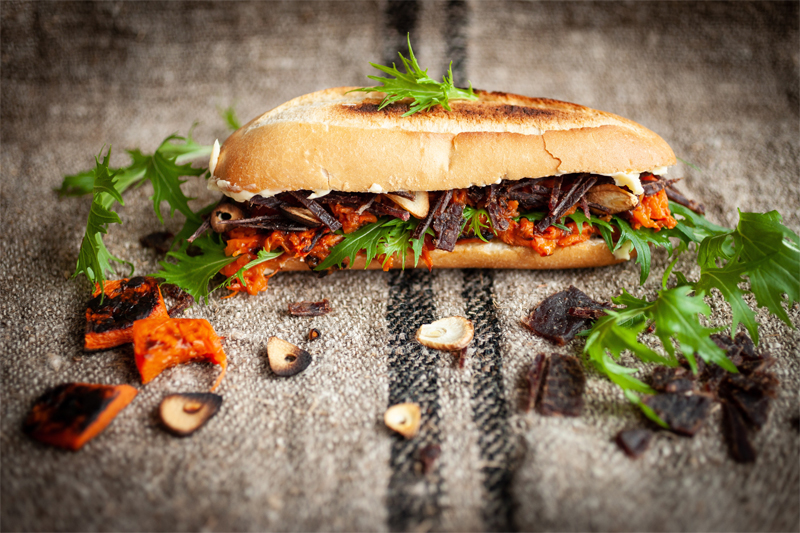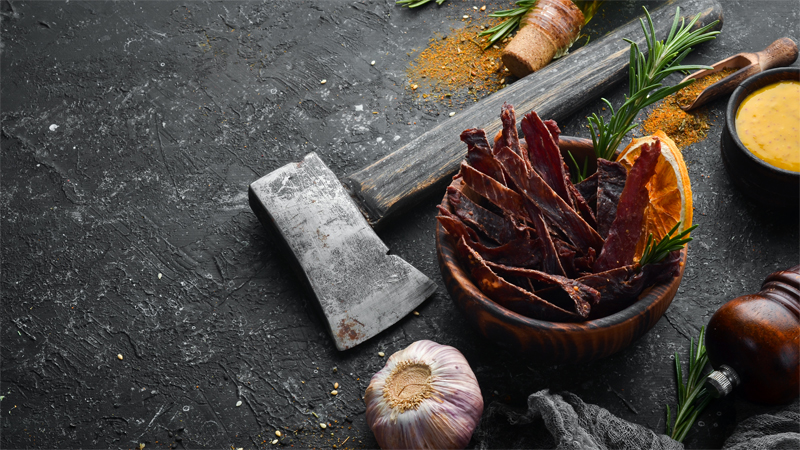 Biltong has become all the rage in savory snacking—but, what is it? Biltong is dried meat, either made from beef, poultry, fish, or other game meats. It’s flavored and air-dried, making it a denser and richer cured meat than you’ve had before.
Biltong has become all the rage in savory snacking—but, what is it? Biltong is dried meat, either made from beef, poultry, fish, or other game meats. It’s flavored and air-dried, making it a denser and richer cured meat than you’ve had before.
That being said, what can biltong be paired with?
While biltong is delicious as a snack of its own, it can also be enjoyed in many different biltong recipe options, including stews, sandwiches, and frittatas, among many others. And, another great benefit of utilizing biltong in your meals is that it’s made from all-natural ingredients and contains no artificial additives.
History Of Biltong
Now that the versatility of biltong has been made apparent, it’s time to learn where biltong came from in the first place.
Biltong was first created in South Africa approximately 400 years ago. When the indigenous South Africans began making biltong, they did so by curing it with salt and hanging it to dry. This was only their original recipe, although it became more complex as time went on.
When the European settlers arrived and introduced different spices, biltong became more sophisticated. Biltong, as it’s known today, wasn’t created until vinegar, pepper, and coriander were added to the curing process.
Biltong was important to sea travel because it was durable and could survive longer trips. It also provided major health benefits, which will be discussed below.
Jerky Vs Biltong
More often than not, those who haven’t heard of biltong will mistake it for the traditional beef jerky snack they’ve grown up munching. However, jerky and biltong are two different food options. Of course, both are types of dried meat that can last for long periods, but that’s about all they have in common.
Biltong is solely a South Arican delicacy, whereas jerky comes from both North and South America. While jerky is known for its wide variety of flavors and high sugar and salt levels, biltong is known for its simple and natural flavors. Beyond taste, biltong and jerky have different cuts as well. Biltong could be fatty or lean (depending on individual taste), while jerky is almost always made of leaner cuts.
And, finally, there’s the process of making each type of meat. Biltong is marinated and cured for a whole day (24 hours) before being hung to dry, which takes up to one week. Jerky, on the other hand, is cut so thinly and cooked on a rack at a low temperature, where it slowly dehydrates.
It’s important to know the discrepancies between jerky and biltong when beginning to cook this food option as it’s different properties can offer different benefits to each new dish you try.
Biltong Recipes
While it’s easy enough to add biltong as a replacement for other dried meats to simple meals, like sandwiches and salads, there are more complex ones. Some of these examples are:
- Muffins: While a muffin made with a salty, dried meat like biltong may not sound appealing, the salty nature of this muffin makes it great to pair with steak or even a soup.
- Bread: Bread made with biltong can have cheese added, and is great toasted and smeared with butter.
- Sushi: With all the variations of sushi that currently exist, why not experiment with biltong in your next sushi roll?
- Cheesecake: The combination of sweet and savory in a biltong cheesecake makes for a delicious and very popular dessert option.
- Biltong Coffee Rub: Take your favorite coffee, like Presto Coffee, add a few other ingredients, and you’ll have a delicious coffee rub to pair your biltong with.
Biltong As A Replacement
A few examples of simple recipes that can utilize biltong include:
- Biltong Baked Potato: This recipe is a spin on the original baked potato. Simply cook your baked potato, like you would normally do. When it’s time to add bacon, replace it with chopped up biltong pieces instead.
- Biltong Quiche: Another dish that utilizes biltong as a replacement for bacon is any quiche recipe you’ve already made with different vegetables and herbs.
- Sandwich: Depending on how you would normally make a cold cut sandwich, biltong can be used as a replacement for any cold cut as well. However, if deciding to make a biltong sandwich, it’s best to use less sauce as the biltong will provide very strong flavors compared to normal cold cuts.
- Salads: If it’s a healthy dish you’re in the mood for, biltong can be added on top of many of your typical salad favorites. As a plus, biltong is rich in both iron and protein, making it a great addition to any healthy meal option.
Biltong Wine Pairings
Beyond food, biltong can be paired nicely with wine and cheese as well. A few wines that go well with biltong are as follows:
- Diemersfontein Shiraz: It has a smokey and charred flavor, mixed with fruits and tannins.
- Meerlust Pinot Noir: This purple-ruby wine has hints of both musk and cherry.
- Beyerskloof Pinotage: This red wine is bold, full-bodied, and has hints of berry, fig, and some spice.
Health Benefits Of Biltong
What makes biltong so good for you? Well, it’s a great source of the following vitamins and minerals:
- Protein: For starters, biltong is a great source of natural protein. This natural protein aids in muscle growth and repair, as well as helps provide a full and satisfied feeling whenever consumed.
- Iron: Beyond protein, biltong is a great source of iron, which helps create red blood cells that carry oxygen around the body.
- Zinc: It’s responsible for creating enzymes that help process carbs, fat, and protein in all the foods you eat, creating energy.
- Vitamin B12: This creates red blood cells, as iron does. B12 also aids in muscle maintenance and keeps the nervous system healthy in general.
- Creatine: This allows for energy production within the body that aids you during workouts or any physical activity you might partake in.
 Conclusion
Conclusion
Whether it’s health benefits you’re looking for or new recipes to try that can replace bacon or other meats, biltong may be where you should be focusing on next. Not only can biltong provide easy swap outs for meats you’re already using, but it can provide entirely new recipes to try, including breads and desserts.

